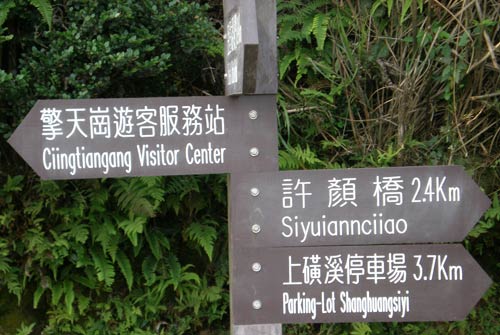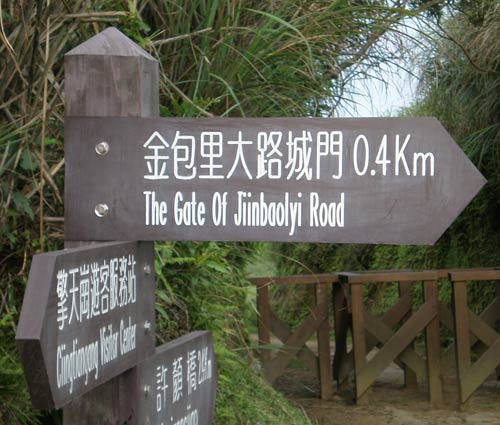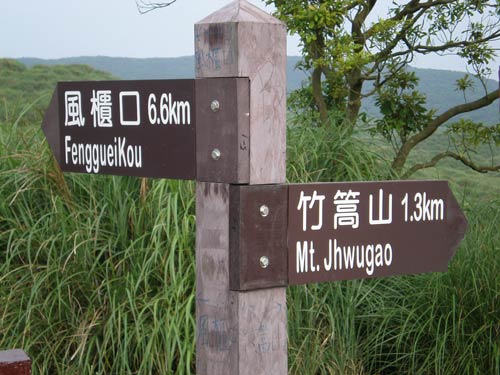The Qíngtiāngāng part of Yangming Shan National Park (Yángmíng Shān Guójiā Gōngyuán / 陽明山國家公園), to the north of Taipei, is distinguished by grasslands high in the mountains — the sort of open, natural place that, though not spectacular, might still make someone used to living in crowded northern Taiwan want to do the Julie-Andrews-hills-are-alive twirl. But, as usual, I’m only going to show you some signs. Here goes.



Ciingtiangang, Siyuiannciiao, Jiinbaolyi. Normally the presence of doubled vowels indicates the use of Gwoyeu Romatzyh (e.g., rice-flour noodles as miifeen rather than Hanyu Pinyin’s mǐfěn). But these signs are most definitely not in Gwoyeu Romatzyh. They’re just really screwed-up Tongyong Pinyin.
| Sign | Tongyong Pinyin | Hanyu Pinyin | Gwoyeu Romatzyh |
|---|---|---|---|
| Ciingtiangang | Cingtiangang | Qíngtiāngāng | Chyngtiangang |
| Siyuiannciiao | Syuyan ciao | Xǔyán qiáo | Sheuyan chyau |
| Shanghuangsiyi | Shanghuangsi tingchechang | Shànghuángxī tíngchēchǎng | Shanqhwangshi |
| The Gate Of Jiinbaolyi Road | Jinbaoli dalu chengmen | Jīnbāolǐ dàlù chéngmén | Jinbaulii dahluh cherngmen |
| FenggueiKou | Fongguei Kou | Fēngguì kǒu | Fengguey koou |
| Mt.Jhwugao | Jhugao Shan | Zhúgāo Shān | Jwugau Shan |
Two of Tongyong Pinyin’s most distinctive features are the use of jh– for what in Hanyu Pinyin is zh– and the use of fong rather than the feng found in Hanyu Pinyin, MPS2, Wade-Giles, Yale, and Gwoyeu Romatzyh. But whoever produced these signs couldn’t get even those right, as shown by Jhwugao and FenggueiKou.
A few misc. notes:
- FenggueiKou: Die, InTerCaPiTaLiZaTion, die! Or in this case perhaps I should write IntercapitalizaTion.
- It’s supposed to be “km”, not “Km”.
- Even the signs that got “km” correct left out the necessary space before it.
- The Gate Of Jiinbaolyi Road: An initial “The” is almost never needed on such signs; indeed, its presence is counterproductive. And the capitalized “Of” is amateurish.
- Parking-Lot Shanghuangsiyi: Oh, that’s just too depressing.
- Ciingtiangang Visitor Center: Leaving out that extra i would help the missing s fit in, as would abbreviating “center” or simply leaving out Qingtiangang altogether. It’s not like there are any other visitors’ centers around there to confuse people. But since the English-speaking world is filled with places marked “visitor center”, it’s probably not worth having mentioned.
- Siyuiannciiao: I’m puzzled that ciao/qiao wasn’t translated as bridge (and written with a space before it). Is there not actually a bridge there?
- Mt.Jhwugao: Again, are spaces really all that difficult?
- I could probably talk about the orthography of a few of the names (e.g., Jinbao Li vs. Jinbaoli, Shanghuang Xi vs. Shanghuangxi, Fenggui Kou vs. Fengguikou); but that’s something well beyond the common awfulness of these signs. And it might also require some research, such as finding the answer to “Is there really a stream [xī] at Shanghuangxi/Shanghuang Xi?”)
The government’s list of Pinyin and English terms related to Yangming Shan National Park, Yángmíng Shān Guójiā Gōngyuán xiāngguān míngcí, doesn’t give any of those incorrect forms. (Anyway, the list, which is in Tongyong Pinyin, is now outdated because of the switch — at least on paper — to Hanyu Pinyin.) And I can’t think of any good reason for the doubled i’s, the interposed y’s, or the other errors. Apparently, these signs are just plain-ol’ awful.
So I don’t have anything particularly interesting to note about the linguistics of this. But I do have a point other than that some typos are weiird weird enough that I can’t help but mention them. Rather, it’s worth noting that just because over the past few years many signs — but not nearly as many people believe — went up in tòng yòng, er, Tōngyòng Pinyin, this doesn’t mean the signs were done properly and wouldn’t require replacement even if Taiwan weren’t switching to Hanyu Pinyin.
